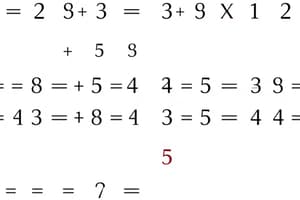Podcast
Questions and Answers
Що з наступного є визначенням перестановки?
Що з наступного є визначенням перестановки?
- Способordering елементів у визначеному порядку (correct)
- Способordering елементів з повторенням
- Способordering елементів без повторень
- Способordering елементів у довільному порядку
Що означає позначення n!?
Що означає позначення n!?
- Кількість елементів у визначеному порядку
- Кількість можливих комбінацій елементів
- Кількість сполучень у визначеному порядку
- Кількість перестановок `n` елементів (correct)
Яка формула обчислює загальну кількість можливих перестановок n елементів?
Яка формула обчислює загальну кількість можливих перестановок n елементів?
- n × (n-2) × (n-4) ×...× 1
- n × (n-1) × (n-2) ×...× 1 (correct)
- n × (n-3) × (n-6) ×...× 1
- n × (n+1) × (n+2) ×...× 1
Яке з наступного є властивістю перестановок?
Яке з наступного є властивістю перестановок?
Де перестановки використовуються в реальних застосуваннях?
Де перестановки використовуються в реальних застосуваннях?
Flashcards are hidden until you start studying
Study Notes
Permutations
Definition
- A permutation is an arrangement of objects in a specific order.
- It is a way of ordering elements from a set, where the order of the elements matters.
Notation
- The number of permutations of
nobjects is denoted byn!(read as "n factorial"). n! = n × (n-1) × (n-2) ×... × 1
Formula
- The formula for permutations is:
n! = n × (n-1) × (n-2) ×... × 1 - This formula calculates the total number of possible arrangements of
nobjects.
Examples
- Permutations of 3 objects:
{a, b, c}can be arranged in3! = 6ways:a, b, ca, c, bb, a, cb, c, ac, a, bc, b, a
- Permutations of 4 objects:
{a, b, c, d}can be arranged in4! = 24ways.
Properties
- The number of permutations increases factorially with the number of objects.
- Permutations are used to count the number of possible arrangements of objects in a specific order.
Real-World Applications
- Permutations are used in:
- Cryptography: to encrypt and decrypt data
- Computer Science: to solve algorithms and optimize code
- Data Analysis: to calculate the number of possible combinations of data
- Biology: to study the arrangement of genes in a genome
Studying That Suits You
Use AI to generate personalized quizzes and flashcards to suit your learning preferences.




